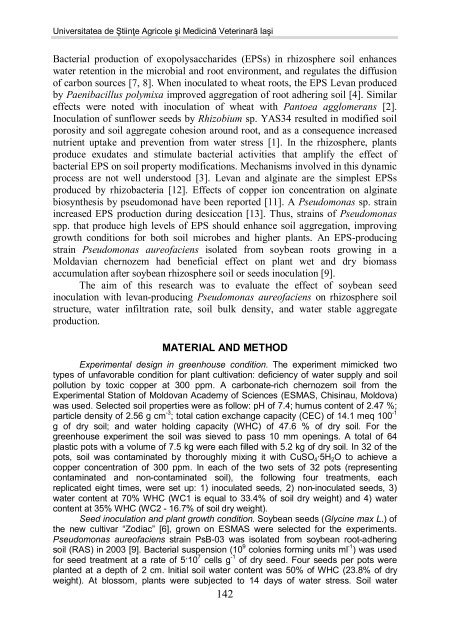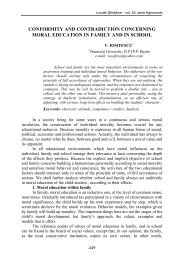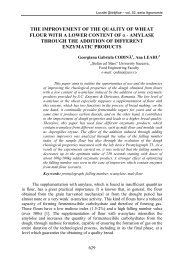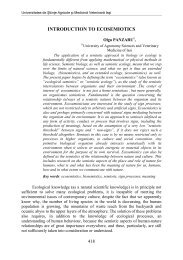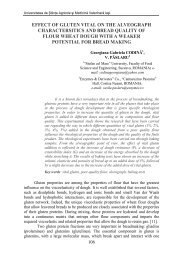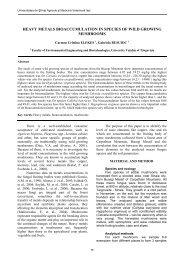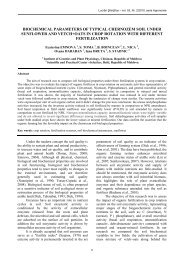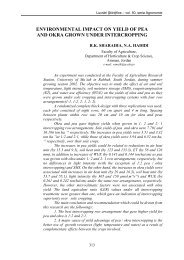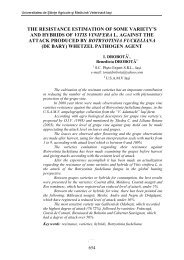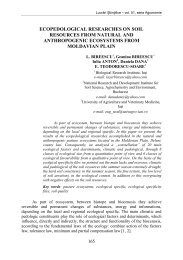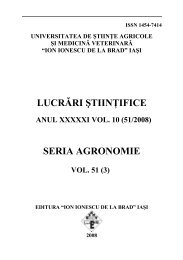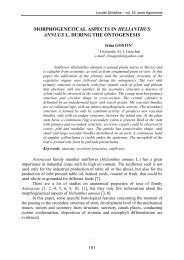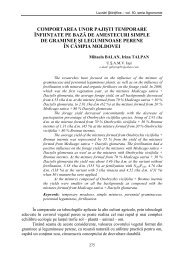rhizosphere soil properties after soybean seed inoculation by levan ...
rhizosphere soil properties after soybean seed inoculation by levan ...
rhizosphere soil properties after soybean seed inoculation by levan ...
You also want an ePaper? Increase the reach of your titles
YUMPU automatically turns print PDFs into web optimized ePapers that Google loves.
Universitatea de Ştiinţe Agricole şi Medicină Veterinară Iaşi<br />
Bacterial production of exopolysaccharides (EPSs) in <strong>rhizosphere</strong> <strong>soil</strong> enhances<br />
water retention in the microbial and root environment, and regulates the diffusion<br />
of carbon sources [7, 8]. When inoculated to wheat roots, the EPS Levan produced<br />
<strong>by</strong> Paenibacillus polymixa improved aggregation of root adhering <strong>soil</strong> [4]. Similar<br />
effects were noted with <strong>inoculation</strong> of wheat with Pantoea agglomerans [2].<br />
Inoculation of sunflower <strong>seed</strong>s <strong>by</strong> Rhizobium sp. YAS34 resulted in modified <strong>soil</strong><br />
porosity and <strong>soil</strong> aggregate cohesion around root, and as a consequence increased<br />
nutrient uptake and prevention from water stress [1]. In the <strong>rhizosphere</strong>, plants<br />
produce exudates and stimulate bacterial activities that amplify the effect of<br />
bacterial EPS on <strong>soil</strong> property modifications. Mechanisms involved in this dynamic<br />
process are not well understood [3]. Levan and alginate are the simplest EPSs<br />
produced <strong>by</strong> rhizobacteria [12]. Effects of copper ion concentration on alginate<br />
biosynthesis <strong>by</strong> pseudomonad have been reported [11]. A Pseudomonas sp. strain<br />
increased EPS production during desiccation [13]. Thus, strains of Pseudomonas<br />
spp. that produce high levels of EPS should enhance <strong>soil</strong> aggregation, improving<br />
growth conditions for both <strong>soil</strong> microbes and higher plants. An EPS-producing<br />
strain Pseudomonas aureofaciens isolated from <strong>soybean</strong> roots growing in a<br />
Moldavian chernozem had beneficial effect on plant wet and dry biomass<br />
accumulation <strong>after</strong> <strong>soybean</strong> <strong>rhizosphere</strong> <strong>soil</strong> or <strong>seed</strong>s <strong>inoculation</strong> [9].<br />
The aim of this research was to evaluate the effect of <strong>soybean</strong> <strong>seed</strong><br />
<strong>inoculation</strong> with <strong>levan</strong>-producing Pseudomonas aureofaciens on <strong>rhizosphere</strong> <strong>soil</strong><br />
structure, water infiltration rate, <strong>soil</strong> bulk density, and water stable aggregate<br />
production.<br />
MATERIAL AND METHOD<br />
Experimental design in greenhouse condition. The experiment mimicked two<br />
types of unfavorable condition for plant cultivation: deficiency of water supply and <strong>soil</strong><br />
pollution <strong>by</strong> toxic copper at 300 ppm. A carbonate-rich chernozem <strong>soil</strong> from the<br />
Experimental Station of Moldovan Academy of Sciences (ESMAS, Chisinau, Moldova)<br />
was used. Selected <strong>soil</strong> <strong>properties</strong> were as follow: pH of 7.4; humus content of 2.47 %;<br />
particle density of 2.56 g cm -3 ; total cation exchange capacity (CEC) of 14.1 meq 100 -1<br />
g of dry <strong>soil</strong>; and water holding capacity (WHC) of 47.6 % of dry <strong>soil</strong>. For the<br />
greenhouse experiment the <strong>soil</strong> was sieved to pass 10 mm openings. A total of 64<br />
plastic pots with a volume of 7.5 kg were each filled with 5.2 kg of dry <strong>soil</strong>. In 32 of the<br />
pots, <strong>soil</strong> was contaminated <strong>by</strong> thoroughly mixing it with CuSO 4 ∙5H 2 O to achieve a<br />
copper concentration of 300 ppm. In each of the two sets of 32 pots (representing<br />
contaminated and non-contaminated <strong>soil</strong>), the following four treatments, each<br />
replicated eight times, were set up: 1) inoculated <strong>seed</strong>s, 2) non-inoculated <strong>seed</strong>s, 3)<br />
water content at 70% WHC (WC1 is equal to 33.4% of <strong>soil</strong> dry weight) and 4) water<br />
content at 35% WHC (WC2 - 16.7% of <strong>soil</strong> dry weight).<br />
Seed <strong>inoculation</strong> and plant growth condition. Soybean <strong>seed</strong>s (Glycine max L.) of<br />
the new cultivar “Zodiac” [6], grown on ESMAS were selected for the experiments.<br />
Pseudomonas aureofaciens strain PsB-03 was isolated from <strong>soybean</strong> root-adhering<br />
<strong>soil</strong> (RAS) in 2003 [9]. Bacterial suspension (10 9 colonies forming units ml -1 ) was used<br />
for <strong>seed</strong> treatment at a rate of 5·10 7 cells g -1 of dry <strong>seed</strong>. Four <strong>seed</strong>s per pots were<br />
planted at a depth of 2 cm. Initial <strong>soil</strong> water content was 50% of WHC (23.8% of dry<br />
weight). At blossom, plants were subjected to 14 days of water stress. Soil water<br />
142


